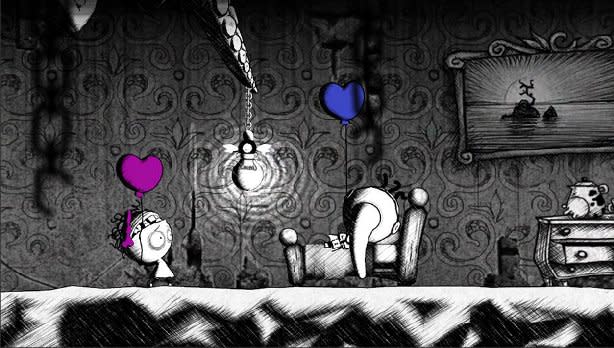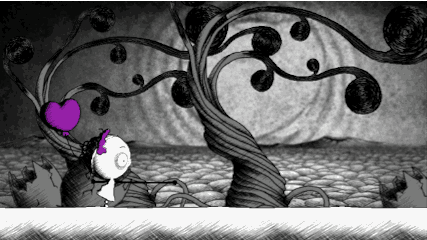Murasaki Baby review: A touch of weird
I'll say it first to get it out of the way: Murasaki Baby looks like something that spawned from the slimy, deliciously quirky mind of Tim Burton. Specifically, Murasaki Baby on the Vita looks like the gamification of Tim Burton's The Melancholy Death of Oyster Boy & Other Stories, a short book of dark children's tales told and illustrated by Burton himself.
It's important to note that this book is short, because it shares that descriptor with Murasaki Baby, and for an apparently similar reason: They're both too strange to support a longer format. From a holistic perspective, Murasaki Baby is a triumph of editing, in recognizing the limits of an absurd idea and executing it to its full potential – and no more.
Murasaki Baby stars a freakishly adorable girl with two wide eyes, expressive eyebrows ... and a mouth on the top of her head. The character design isn't the weird thing about Murasaki Baby, though – the strangest aspect of the game is how it controls. You don't press any buttons on the Vita or touch the analog sticks to move Baby forward. Instead, you touch the screen ahead of her, literally holding her stick-figure hand through the levels, pulling her across gaps, over obstacles and through puzzles. She looks at you with those big, sad eyes when she's scared, as if begging you to please, no, don't make her enter the scary, dark area of the map.
And the controls get weirder, mostly using the Vita's front and rear touch pads, and throwing in the gyroscope in some sections. This is why it's a boon that Murasaki Baby is so short: The controls are so odd that they'd be offensive in a longer game. As it stands, they're sporadically awkward, at times slightly annoying, but overall they present a clever, novel input idea.
Every humanoid creature in Murasaki Baby has a mouth on his or her forehead, and they tend to carry around heart-shaped balloons. Baby's balloon is purple, and if it pops, you lose that particular section of the game and have to replay it. When you come across other characters with different-color balloons, you tap to pop them, and those colors become a new game mechanic in the form of colored backgrounds. Swipe across the back of the Vita to uncover these new backgrounds and their unique abilities: The bright blue background allows you to control electricity; the yellow one makes a giant bunny-like creature jump down and shake away loose stones in your path; the light blue one freezes things (including your balloon); the purple one alters gravity as you turn the Vita upside down.
There are others, and they're combined in different ways to solve Murasaki Baby's puzzles, fingers flipping constantly across the rear touch pad to switch out the colors, tapping to make the different elements work, at times while still holding Baby's hand to walk her forward. That's a lot to keep track of, and this meta-game of finger contortion gets frustrating at times.
To be clear: I hate the Vita's rear touch pad. I hate how, in games that use it, I'm constantly aware of where my fingers are brushing the back of the Vita, even just barely. I hate how obsessively I have to think about the way I'm holding my hands. I've never encountered a game that successfully made me even just OK with Vita's rear touch pad.
Until Murasaki Baby.

Recent Reviews
With all of that laid bare, my bursts of frustration with the game's control scheme stem from losing a level and the impulsive rationalization that these controls obviously aren't working, that this game would be better served as a single-stick platformer and button-masher. But then I finish the level using a rapid combo of flicks, taps and slides, and it feels pretty damn awesome. There's even one section that does allow you to use the sticks and buttons, but it only serves to highlight how comfortable we already are with these mechanics, not necessarily how bad the alternative scheme is.
The controls are different and at times inelegant (and yes, they can cause slight cramps), but they're probably not the reason you'll fail some of the levels. These areas are designed to be tricky, and in this regard they succeed. Don't hate the player controls; hate the challenging design.
On the surface, Murasaki Baby is a straightforward puzzle-platformer, but the grim art style and playful mechanics turn it into an utterly fresh, creative game. There's no dialogue, but Baby and the other characters make cute little noises that help convey a rich, emotional narrative capped off by an entirely-too-adorable final scene.
I wish I could play Murasaki Baby for hours upon hours, even though I'm glad I can't. The game works as a limited experience, something novel and adorable and emotional, and it knows not to be anything more. For what it is, it's perfect(ly morbid).

This review is based on a pre-release PSN download of Murasaki Baby, provided by Sony. Images: Sony.
Joystiq's review scores are based on a scale of whether the game in question is worth your time -- a five-star being a definitive "yes," and a one-star being a definitive "no." Read here for more information on our ratings guidelines.



